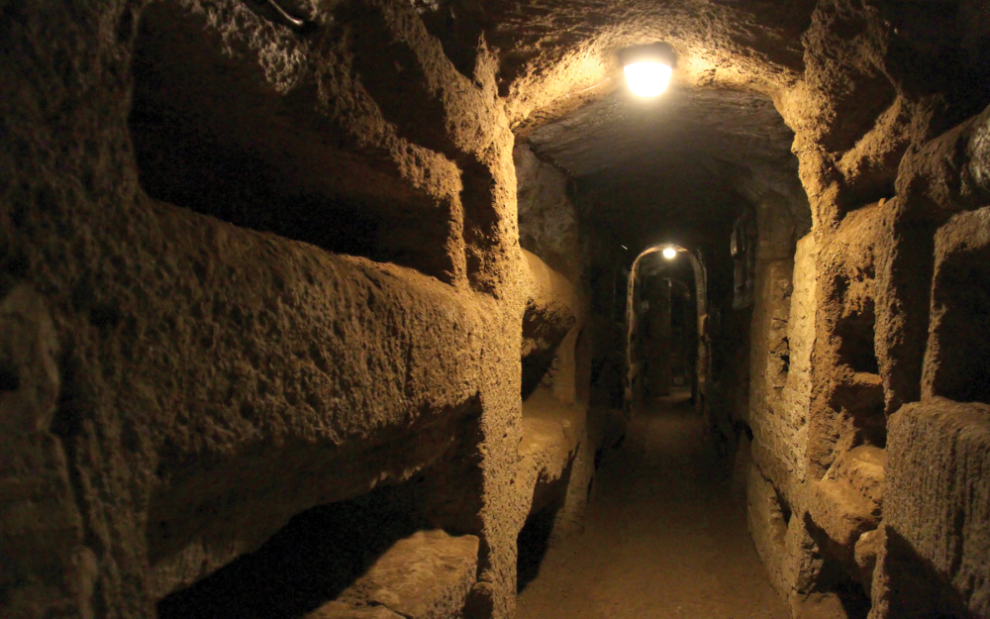In Rome, one of my favorite places to take my students is the Catacombs of St. Callixtus. There is something mysterious about descending below ground, almost stepping back into the past. Despite abundant rumors and myths, Christians never hid in the catacombs, where they would have been easy targets for Roman authorities. Instead, early Christians gathered there to worship and pray, to be in communion with those who had died, and to unite in the hope of resurrection.
On my last visit, our tour guide asked us to imagine what it was like for Christians in the fourth century. As if on cue, we began to hear the Lord’s Prayer emanating from a side chamber. An American pilgrim group was gathered around an altar in prayer. Past and present colliding, the dynamic reality of the Christian tradition came alive for my students in a new way.
Christianity is a religion deeply embedded in history. We believe the incarnation occurred, God became human, in a particular time and place. At its best, Christianity has a deep appreciation of context.
In the Didache, a late first- or second-century Christian handbook, the passage on baptism is a perfect example. Christians are, of course, to baptize “into the name of the Father, and of the Son, and of the Holy Spirit,” but then the text goes further, stating that baptisms should occur “in living water. But if you have not living water, baptize into other water; and if you can not in cold, then warm. But if you have not either, pour out water thrice upon the head into the name of the Father, and Son, and Holy Spirit.” In its attention to context and contingencies, the Didache can help us envision what it means to not let the perfect become the enemy of the good, to paraphrase Voltaire.
Christians no longer gather in cemeteries in the same way, yet there is a deep truth within that historic tradition that continues. Christians still come to pray in that space in hope of the resurrection. Baptism remains the center of how we understand ourselves to be called by God to follow Christ. In some ways, 21st-century Catholicism is radically different from the fourth-century church. And yet, as we walked toward 21st-century Christians praying the Lord’s Prayer in a space consecrated by fourth-century pilgrims, the liminal reality of Christianity as a living tradition was palpable.
This moment has been on my mind since reading the Instrumentum Laboris, or preparatory document, for this month’s synod session.
“A synodal Church,” the document explains, “is founded on the recognition of a common dignity deriving from Baptism, which makes all who receive it sons and daughters of God, members of the family of God, and therefore brothers and sisters in Christ, inhabited by the one Spirit and sent to fulfil a common mission.”
While only a few will participate in the formal synod meeting, all the baptized are invited to join this journey focused on communion, mission, and participation. How can those of us who are not at the synod still be part of listening more attentively to the Holy Spirit and becoming a more synodal church?
The synodal process of prioritizing listening and dialogue is challenging. For some, it is scary or painful. However, these divisions and fears are not new within that horizon of tradition and history.
Amanda Osheim notes in an article for Theological Studies that one shift in the current moment is that for Pope Francis, “synodality is primarily baptismal rather than hierarchical.” In calling for us all to journey together, listening more intently to the Holy Spirit and our neighbors, the pope envisions the synod on synodality calling us to discern our own baptismal vocations.
“Baptism thus creates a true co-responsibility among all the members of the Church, which is manifested in the participation of all,” explains the Instrumentum Laboris, “with the charisms of each, in the mission of the Church and the building up of the ecclesial community.” Practically, Osheim explains, “synodal practices and structures will be needed in order to develop listening and discernment as personal and communal habits of the pilgrim people of God, as well as to foster an understanding of faith incarnated in the diverse cultural and historical contexts.”
Journeying together in this way requires asking difficult questions about justice and participation in both the world and the church. In 1971, the Synod of Bishops argued that “action on behalf of justice and participation in the transformation of the world fully appear to us as a constitutive dimension of the preaching of the Gospel” and therefore part of the redemptive mission of the church.
In 2023, as the Synod on Synodality meets, I pray that as the pilgrim people of God we will embrace the baptismal invitation to journey together, acting for justice in the transformation of the world and the church.
This article also appears in the October 2023 issue of U.S. Catholic (Vol. 88, No. 10, pages 40-41). Click here to subscribe to the magazine.
Image: iStock.com/AarStudio














Add comment